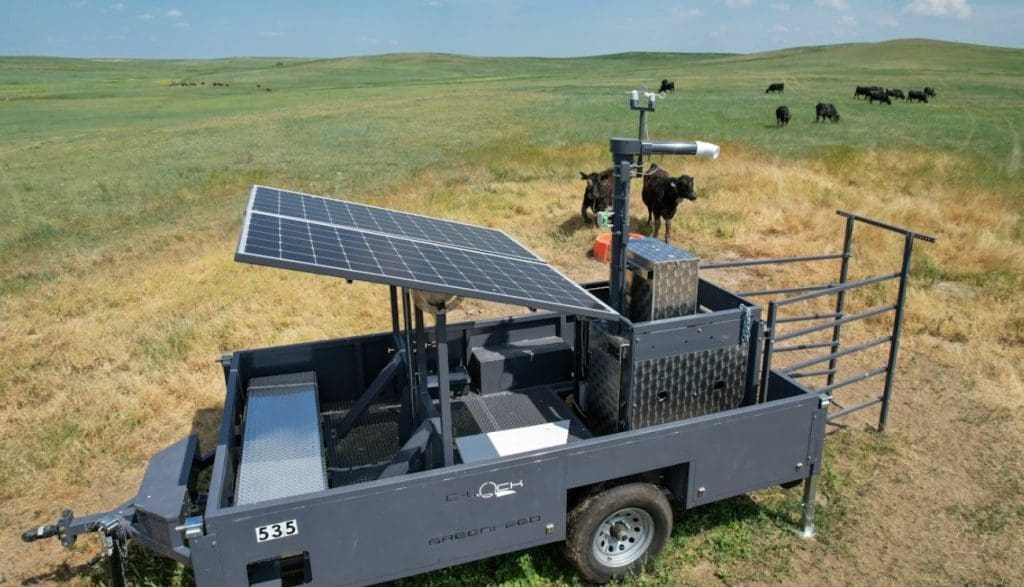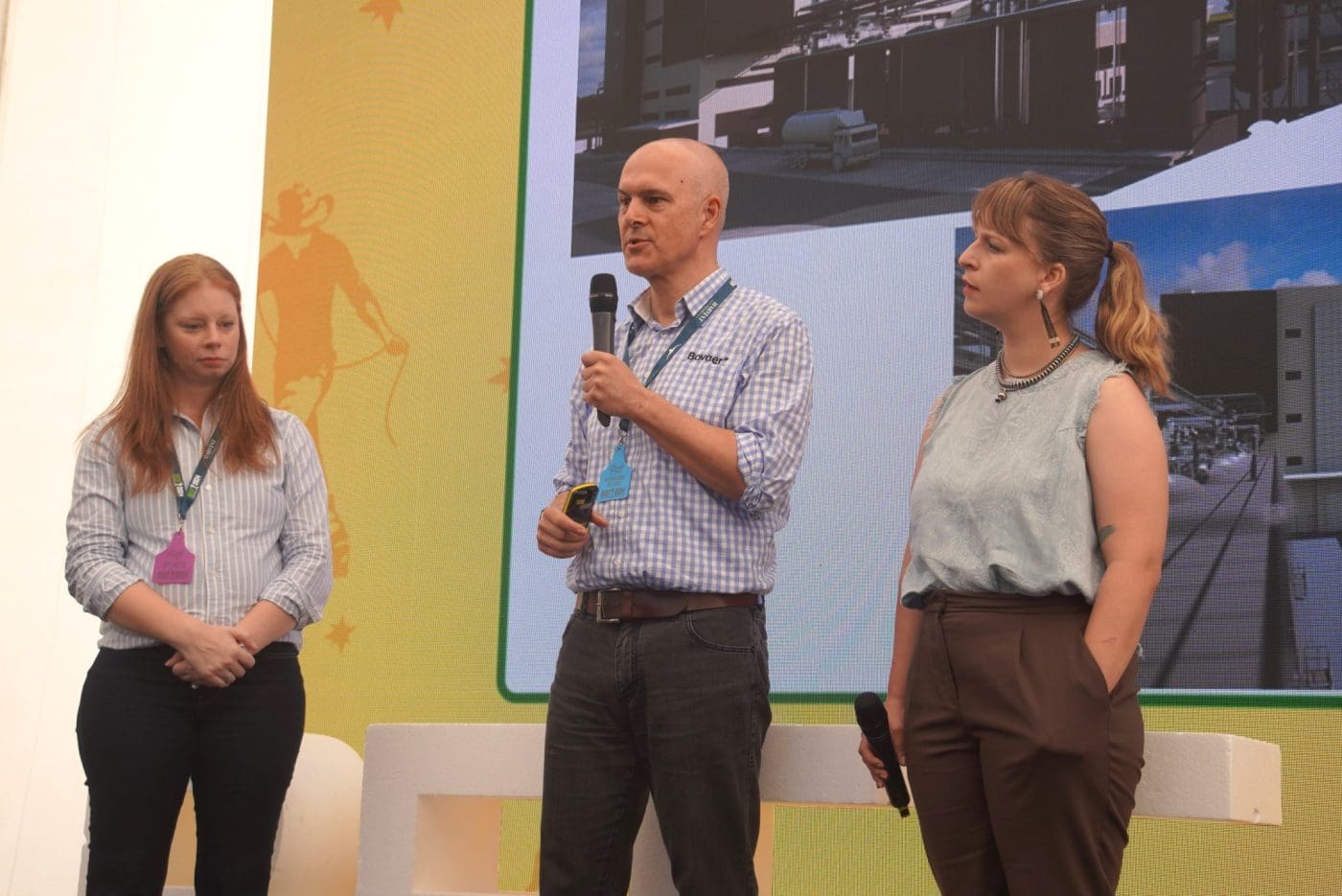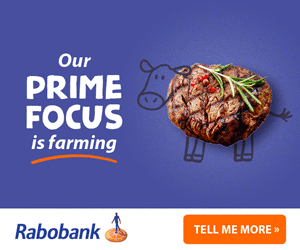
GreenFeed unit in use in a paddock setting in the US Central Plains region. Click on image for a larger view
TUCKED away among the myriad examples of ag technology on display at Beef 2024 this month were some absolute gems, offering exciting future opportunities for the beef industry.
One of the presentations in the event’s Tech Yards precinct highlighted a piece of US-developed technology called GreenFeed, designed to provide easy, accurate measurement of ruminant animals’ methane output in either paddock environments or feedlots.
The mobile, trailer-mounted technology has wide potential application in Australia not only for genetic selection (methane production has been shown to vary widely from animal to animal), but also for verification purposes in cattle populations receiving feed additives designed to mitigate methane output. That applies especially for cattle being directed into brand programs carrying sustainable or low-methane claims.
Individual animal methane readings taken by the equipment as the animal feeds can be linked back to National Livestock Identification System tags scanned at the same time, to individually identify poor and good performers.
Dr Meredith Harrison from C-Lock, the company behind the GreenFeed system, told a Beef 2024 Tech Yard audience the technology had now been used in well over 60 trials worldwide, including some of the initial field validation work with anti-methanogenic feed additive manufacturer Bovaer.
The company was ‘well before its time’ in terms of industry-wide methane awareness, having sold its first commercial unit way back in 2011.
The GreenFeed apparatus is built around a portable head-chamber system, attracting animals to the site with a small pelleted feed ration delivered from a hopper, designed to attract each animal multiple times each day.
It can be used with both beef and dairy cattle and smaller ruminants like sheep and goats. Bison and deer have also been tested with the equipment in the US. It is also possible to aggregate emissions data from individual animals to determine herd averages.
The apparatus measures both methane and CO2 gasses expelled by the animal during each feeding, as well as the presence of hydrogen and oxygen, if required.
“CO2 is also an important component when looking at these methane mitigating supplements, because it’s the ratio of the two gasses that helps determine how effective they are,” Dr Harrison said.

GreenFeed’s Dr Meredith Harrison, right, with Dr Maik Kindermann from DSM, and the University of Queensland’s Dr Sarah Meade fielding questions during the Beef 2024 Tech Talk session
The gas emissions data gathered by sophisticated sampling sensors is logged, then processed allowing the operator to easily access a summarised report of calculated emissions. Data is transferred from the paddock either by W-Fi or cellular. Results from each GreenFeed unit can be monitored from anywhere in the world, in real-time.
Each GreenFeed machine has the ability to service 40 or 50 animals in a paddock setting, depending on whether it is being used in a feedlot or grazing system. Gas concentrations are reported in parts per million, calibrated for each location.
Dr Harrison said on average, animals visited the site two or three times per day.
 So how accurate is the technology? A new, upgraded NDIR* laser-based sensor system can measure methane in each sample down to 1 gram per day per animal variants, meaning the readings are highly sensitive and highly specific.
So how accurate is the technology? A new, upgraded NDIR* laser-based sensor system can measure methane in each sample down to 1 gram per day per animal variants, meaning the readings are highly sensitive and highly specific.
On average, trials have shown GreenFeed units’ measurement of methane is within 1pc of more sophisticated laboratory-type measurement technologies.
‘That’s really important when measuring cattle supplemented with a product like Bovaer, where we need to be able to detect those really low levels of methane,” Dr Harrison said.
In terms of repeatability of measurements, a comparison of two different GreenFeed systems showed an R-squared value of 0.93, indicating ‘really good agreement’ between the two units used in this trial.
Because gas emissions are impacted by factors like temperature and humidity, a coefficient is used to adjust recordings for different environmental conditions.
For paddock-based installations away from mains power, solar panels can be used to drive each GreenFeed unit.
Asked about the variation in methane output between individual animals in any given group, Dr Harrison said depending in diet, anywhere from 10pc to 20pc variation within a group was common.
Small numbers of GreenFeed measurement units are already in Australia, being used for research purposes at sites like UNE Armidale and by the Australian Agricultural Co.
* NDIR, or non-dispersive infrared, is a sensor technology used to measure carbon dioxide and methane. The sensor works by using an infrared lamp to direct waves of light through a tube filled with a sample of air (in this case, an animal’s breath sample). This air moves toward an optical filter in front of an IR light detector. The IR light detector measures the amount of IR light that passes through the optical filter.
Editor’s note: Australia’s in-field cattle weighing systems manufacturer Agscent Optiweigh also offers an optional methane monitoring solution. Click here for details.
